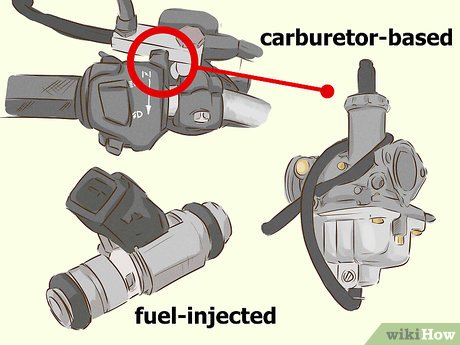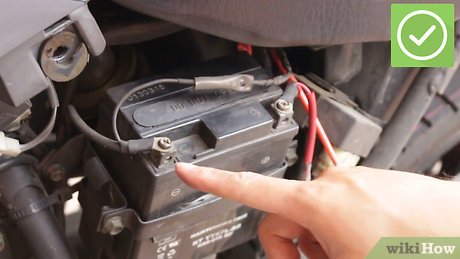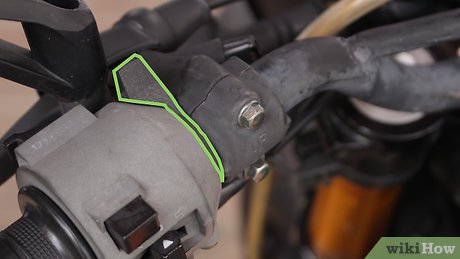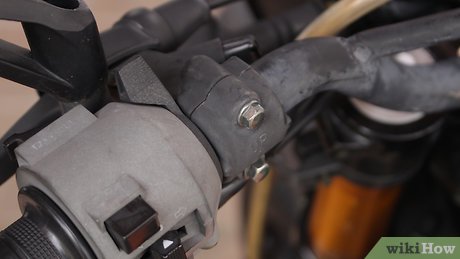How to Start a Motorcycle
Method 1 of 3:
Getting your Bearings
-
 Determine whether you have a carburetor-based or fuel-injected motorcycle. Many motorcycles, especially older or less expensive models, do not have modern fuel injection systems. If you aren't sure, you can tell by looking for a choke control. It is normally located on the left handlebar, above the horn. Carbureted motorcycles have a choke, but fuel-injected bikes do not.[1]
Determine whether you have a carburetor-based or fuel-injected motorcycle. Many motorcycles, especially older or less expensive models, do not have modern fuel injection systems. If you aren't sure, you can tell by looking for a choke control. It is normally located on the left handlebar, above the horn. Carbureted motorcycles have a choke, but fuel-injected bikes do not.[1] -
 Sit on your motorcycle seat when starting it. This will put you in full control of anything that happens once it's started. If you are starting the motorcycle unmounted for some reason, make sure that you shift your bike into neutral (located between 1st and 2nd gear) before you fire the engine. You don't want the bike to take off without you!
Sit on your motorcycle seat when starting it. This will put you in full control of anything that happens once it's started. If you are starting the motorcycle unmounted for some reason, make sure that you shift your bike into neutral (located between 1st and 2nd gear) before you fire the engine. You don't want the bike to take off without you! -
 Make sure that the motorcycle is in working condition. You should have plenty of gas and a well-charged battery. It is important to keep the motorcycle properly serviced, particularly in damp or cold conditions. Fit new spark plugs, or, if not worn, clean and gap the old ones. Check the ignition timing, and adjust if necessary; if fitted, have the ignition points replaced. A carburetor service and clean is also a great idea.
Make sure that the motorcycle is in working condition. You should have plenty of gas and a well-charged battery. It is important to keep the motorcycle properly serviced, particularly in damp or cold conditions. Fit new spark plugs, or, if not worn, clean and gap the old ones. Check the ignition timing, and adjust if necessary; if fitted, have the ignition points replaced. A carburetor service and clean is also a great idea.- Replace the spark plug leads if they look old, worn, or frayed. Use only manufacturer-recommended spark plugs and plug leads – look for the reference in your motorcycle's handbook.
-
 Check the oil level. Before starting any engine, make sure it is lubricated by checking the oil level. If there is no oil, or the oil level is too low, do not start the engine. Otherwise it will heat up, then will break down.
Check the oil level. Before starting any engine, make sure it is lubricated by checking the oil level. If there is no oil, or the oil level is too low, do not start the engine. Otherwise it will heat up, then will break down. -
 Check the battery. Put in the key and turn the key clockwise until the lights turn on. If the lights does not turn on, that usually means the battery is dead and you need to recharge it or install a new one.
Check the battery. Put in the key and turn the key clockwise until the lights turn on. If the lights does not turn on, that usually means the battery is dead and you need to recharge it or install a new one.
Method 2 of 3:
Starting a Carburated Motorcycle
-
 Look for the "choke" lever or cut-off switch. For cold starting, there is usually a choke lever or "cut-off switch" on the handlebar. On some bikes, there may be a choke lever mounted on the carburetor. Operating this will provide the necessary rich fuel mixture when the motorcycle is "cold" – when it hasn't been used for more than a few hours. The dirtier the carburetor, or the colder the engine is, the more the choke will need to be engaged.[2]
Look for the "choke" lever or cut-off switch. For cold starting, there is usually a choke lever or "cut-off switch" on the handlebar. On some bikes, there may be a choke lever mounted on the carburetor. Operating this will provide the necessary rich fuel mixture when the motorcycle is "cold" – when it hasn't been used for more than a few hours. The dirtier the carburetor, or the colder the engine is, the more the choke will need to be engaged.[2]- You don't need to use the choke lever when starting a motorcycle "hot." If the motorcycle has been running and the engine is already hot, you won't need as much power to get it going. Just use a small amount of throttle and the engine should fire.[3]
- Many bikes have a cut-off switch on the kickstand, so make sure that the kickstand is up as well. Having the bike in neutral will disable the kickstand shutoff.
-
 Open the choke lever. Make sure that the cut-off switch is "on." You will need to leave the handlebar throttle twist-grip closed while operating the starter motor or kick-start lever. Otherwise, the engine will flood, making starting difficult or impossible. Remember – the choke lever is usually not necessary if the bike has already been running in the past few hours.[4]
Open the choke lever. Make sure that the cut-off switch is "on." You will need to leave the handlebar throttle twist-grip closed while operating the starter motor or kick-start lever. Otherwise, the engine will flood, making starting difficult or impossible. Remember – the choke lever is usually not necessary if the bike has already been running in the past few hours.[4] -
 Turn your ignition to the "on" position. Your dash lights should "light up" when it's in this position. Also if your bike is in neutral as suggested, then you should notice a green light indicating that you are in neutral.
Turn your ignition to the "on" position. Your dash lights should "light up" when it's in this position. Also if your bike is in neutral as suggested, then you should notice a green light indicating that you are in neutral. -
 Start the engine. Squeeze and hold your clutch lever down (located on the left) and push the start button (located on the right). You should hear the blissful sound of your motorcycle cranking up.
Start the engine. Squeeze and hold your clutch lever down (located on the left) and push the start button (located on the right). You should hear the blissful sound of your motorcycle cranking up. -
 Close the choke and open the throttle. Shortly after the engine fires, close the choke lever progressively and open the throttle slightly as the engine warms. As you ride, you may still need some choke for a short distance – but close the choke lever as soon as possible to achieve smooth running. Do not over-rev the motorcycle when it is warming up.
Close the choke and open the throttle. Shortly after the engine fires, close the choke lever progressively and open the throttle slightly as the engine warms. As you ride, you may still need some choke for a short distance – but close the choke lever as soon as possible to achieve smooth running. Do not over-rev the motorcycle when it is warming up.
Method 3 of 3:
Starting a Fuel-Injected Motorcycle
-
 Put the motorcycle into neutral. You can almost always find this between first and second gear.[5]
Put the motorcycle into neutral. You can almost always find this between first and second gear.[5] -
 Don't worry about the choke lever. For electronically fuel-injected motorcycles, the engine management system will automatically look after fueling needs whether the engine is hot or cold. There is no choke lever on these motorcycles. Use a small amount of throttle when starting either hot or cold.
Don't worry about the choke lever. For electronically fuel-injected motorcycles, the engine management system will automatically look after fueling needs whether the engine is hot or cold. There is no choke lever on these motorcycles. Use a small amount of throttle when starting either hot or cold. -
 Pull the clutch in toward the handlebar. It's usually on the the left-hand side. Many riders choose to also pull in the front brake (on the right handlebar) at the same time.
Pull the clutch in toward the handlebar. It's usually on the the left-hand side. Many riders choose to also pull in the front brake (on the right handlebar) at the same time. -
 Press and hold in the start button. This is usually located on the right handlebar, near the bottom of where the hand will naturally rest.
Press and hold in the start button. This is usually located on the right handlebar, near the bottom of where the hand will naturally rest. -
 Try using the throttle. If the motorcycle does not catch and start, try using the throttle while pressing the start button. Make sure to keep the clutch held all of the way in while doing this.
Try using the throttle. If the motorcycle does not catch and start, try using the throttle while pressing the start button. Make sure to keep the clutch held all of the way in while doing this.
4 ★ | 2 Vote















 How to Deal With a Minor Car Accident
How to Deal With a Minor Car Accident How to Open a Gas Station
How to Open a Gas Station How to Get a Motorcycle License
How to Get a Motorcycle License How to Unwobble a Bicycle Rim
How to Unwobble a Bicycle Rim How to Use Jack Stands
How to Use Jack Stands How to Drive Long Distances Alone
How to Drive Long Distances Alone